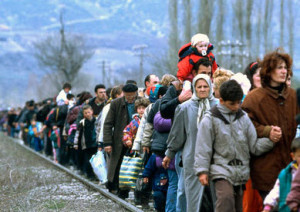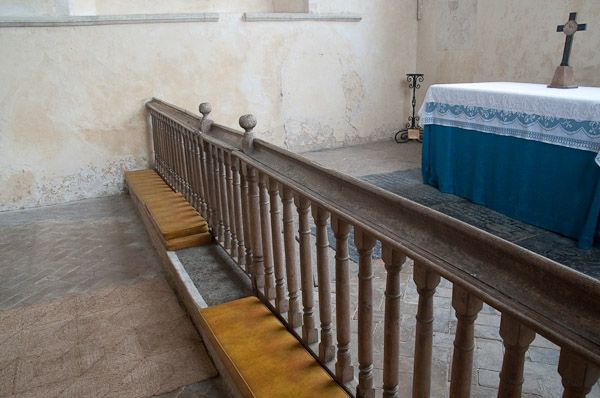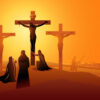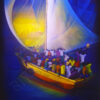 Do you have a box of old photos? I have several and the photos span quite a range of years. Some photos date back before I was born like the one of my father standing in a square in Franconville, France on May 8, 1945 – VE Day. Others are of family gatherings, thanksgiving turkey, people gathered around kitchen tables, people lined up in front of Christmas trees, vacation vistas, or just the living room wall at my grandmother’s place.
Do you have a box of old photos? I have several and the photos span quite a range of years. Some photos date back before I was born like the one of my father standing in a square in Franconville, France on May 8, 1945 – VE Day. Others are of family gatherings, thanksgiving turkey, people gathered around kitchen tables, people lined up in front of Christmas trees, vacation vistas, or just the living room wall at my grandmother’s place.
In many of these pictures I note the presence of an older (he was always old as far as I can recall) gentleman with a shy smile. He is gray of hair and complexion. I always called him Uncle Joe. But I know he wasn’t really my uncle. Joe Bunell, He later married Agnes who was a childhood friend of my mother’s. He and his family were almost always on hand at holiday and family gatherings.
When I was a teenager I remember asking my mother: “Who is Joe Bunell? How does he fit in our family?” My mother told me a story. It was a story about an event that happened a long time ago In a world that was very different from today’s. My mother was born in 1914. Which means that this story took place when she was perhaps about 10 years old. Think of the world in 1924. I’m sure it was very different.
My mother had three sisters and a brother and all of them had gone to church this one Sunday. They were Catholics, Irish Catholics. They grew up in South Boston, the Irish enclave. This particular Mass they attended that Sunday morning was not unlike others with the exception that at the end of the Mass, before they were dismissed, the priest brought out a group of children. He lined them up along the altar rail, a group of frightened children. He explained that these children were orphans. They had no home. The priest asked if any of the families there would be willing to take one of the children home. It was a very unconventional and perhaps not very safe adoption process. But things happened like that in 1924. Perhaps the fate of those children was better served by this unconventional process then languishing in the orphanages of the day. So people made their selections and headed home. My mother noticed that there was one little boy who was not selected by any family but was left there alone.
My mother and her sisters and brother went home. They told their mother and grandmother, who were at home, the story about what had happened, of how the children were brought out along the altar rail, how people had taken almost all the children home except for one little boy. Apparently with very little hesitation, my grandmother and great-grandmother concurred and told my mother to go back to the church, right then, find the priest and tell him that we will take that boy home. So that’s what happened. That’s how Joe Bunnell came to be part of my extended family. He stayed with my mother’s family for most of his adolescence. He did try to return to his family at one time but found the environment not safe or welcoming and returned to my mother’s house where he was welcomed back. I’m sure that Joe’s life was filled with a lot of anxiety and fear. I’m sure that it wasn’t easy for him. But he did have some safety and happiness within my mother’s home. That adopted home became a foundation for him to build a rich and full life.
Last Sunday, Pope Francis, during one of his evening talks to the crowd in St Peter’s Square made an announcement that every Catholic Church,  monastery, convent, and institution, that every one of them was exhorted to take in one refugee family and the two parishes within Vatican City would be doing so.
monastery, convent, and institution, that every one of them was exhorted to take in one refugee family and the two parishes within Vatican City would be doing so.
As you know there is an enormous refugee crisis now in Europe The greatest crisis probably since the end of World War II. The Pope essentially, in that announcement, attempted to do a very old fashioned thing. He was lining up all the refugees of Europe along his altar raid and exhorting his congregation, locally and globally, to take a family home. I don’t think I have to spend a lot of time explaining why this crisis is a crisis for the entire Christian Church. I don’t think that we need to reflect that deeply on why this is the case. Our church, the Christian Church, has its roots in the poor and the dispossessed, in the fearful and the anxious. Think about them gathered in that upper room on that night that we remember over and over again—here in worship at Sanctuary UCC and throughout Christendom—we remember that night when he gathered his disciples and Jesus gave himself to them in a new and transformative way. We enact that night over and over so that we might gaze into each other faces participating in the sacrament of life and see salvation.
It’s probably worth reflecting that there must have been a lot of anxiety in that room, a lot of fear. Their leader was a man who was wanted, he was wanted by the crowds that flocked around him. But he was also wanted by the authorities that had placed a price upon his head. They weren’t in flight at that moment but they knew that it could become necessary at any moment to run and hide as they would in just several days after that meal. This was something they were familiar with, it was part of their history, and the Jewish people have a history of being refugees in flight. Looking for their home, not being welcomed, and being turned away. Our church has its roots in people that often found it hard to find a place to be at home. We should not forget that we and many of our ancestors, some of them quite recently, came to this country because they were in fear or in danger or persecuted in their homelands. They came as refugees. Unfortunately we don’t have the best history of welcoming refugees but we have managed to do our share at points in history. Our deep communal sense of compassion has consistently shone through.
Christians have a distinct responsibility. It leads back to that night in the upper room and even before that. Our responsibility goes back to and proceeds from the deepest mystery of our transformative faith. In Jesus, the transformative mystery that we refer to as God became part of us in a way that we could fully recognize and understand. When, in the Gospel of Mark, Jesus asks his disciples two questions “Who do people say that I am?” and “Who do you say that I am?” he was also asking us about ourselves.
When a person of faith gazes into the face of Jesus it is to gaze into a mirror where we see a transformed version of ourselves. We do not see some person of history, we do not see a stick figure historical Jesus that changes no one, we see salvation and it looks just like us. Peter says “You are the Messiah.”
When a person looks into the face of Jesus they see salvation, they see hope in the midst of a dangerous and anxious world. That hope in the face of uncertainty if it is to be found must look like us or it isn’t there.
When that young man Joe stood with the others before the altar rail and saw that church empty out—how desolate he must have felt. Five little children who rushed back to the church to offer him sanctuary were the face of Jesus. They didn’t know that. We usually don’t.
Pope Francis (and he’s not alone), has brought the refugees of this global crisis and lined them up before us, at the altar rail. Do they see the church emptying out? Can we look at them and ask the question, “Who do you say that I am?” Are we willing to be face of salvation?
Or, are we afraid to hear the answer? Who do you say that I am? Who do you say that I am? Who do you say that I am?
Rev. Fred Hayes – 9/11/2015





